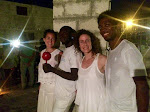Saturday morning I went to the peristil to help decorate. There were heaps of multi-colored plastic banners and fabric flags that had to be untangled and hung inside as well as in the plaza area in front of the peristil and inside a courtyard with a tree for the lwa Ayizan. My traveling companions went into town for provisions such as water, fruit, and vegetables while I stayed and assisted the all-male group of decorators. I had only been in Haiti for two days so my kreyol at this point was minimal. We communicated mostly through gestures, nods, and of course, smiles.
That evening the ceremony started in the inner sanctum -- a room attached to the open space of the peristil that was for ceremonial work by the initiated and where the uninitiated could peak through windows on their tiptoes. We were allowed to watch but I soon realized cameras were not. There were over a hundred ounsi, or initiated participants, all dressed in their finest whites including head wraps, sitting in benches facing the altar space. The sèvitè sat in front of the altar space that was decorated with flowers, lit candles, images of the saints, and I imagine other offerings for the lwa. The lead singer, or larenn, sat against the wall next to the sèvitè playing the tchatcha, a maraca-like shaker instrument leading the chorus of ounsi in call and response singing. At this point there were no drums.
An ounsi would become possessed by a spirit or lwa and run as if catapulted to the front of the room by the altar. This seemed to happen when the spirit moved them rather than in a particular order. They would then crawl across the front of the room by the altar to the side corner and on to the back where they were then greeted and helped up to return to their seat. This went on for an hour or so. According to David Yih, they are singing a song cycle that is not repeated in the outer temple space. It's called "lè y ap noble lwa-yo" or "when they are greeting the lwas."5 Despite the Daome lwas being mute, they are greeted and asked how they are doing upon arriving to this part of the ceremony. After this song cycle, song cycles from the two main Souvenance "camps" of lwas are performed -- Chasè and Grenadye.6
5 Yih, p. 265.
6 Yih, p. 265. On pages 126-127 Yih refers to the chasseurs and the grenadiers as French soldiers. Light infantry included chasseurs à pied and chasseurs à cheval. The grenadiers "were taller men and were used as shock troops." Haitian leader Jean-Jacques Dessalines' infantry also had chasseurs and grenadiers. Yih posits that just as Desslines was immortalized in Vodou folklore so perhaps was his army. About thirty-six lwa belong to the ekip (teams), kan (camps), or batayon (batallions) of Chasè and Grenadye at Souvenance. Each has its own leader or chef, as well as its own rhythms and dance steps. The Chasè lwa are greeted first followed by the Grenadye.
Subscribe to:
Post Comments (Atom)

No comments:
Post a Comment